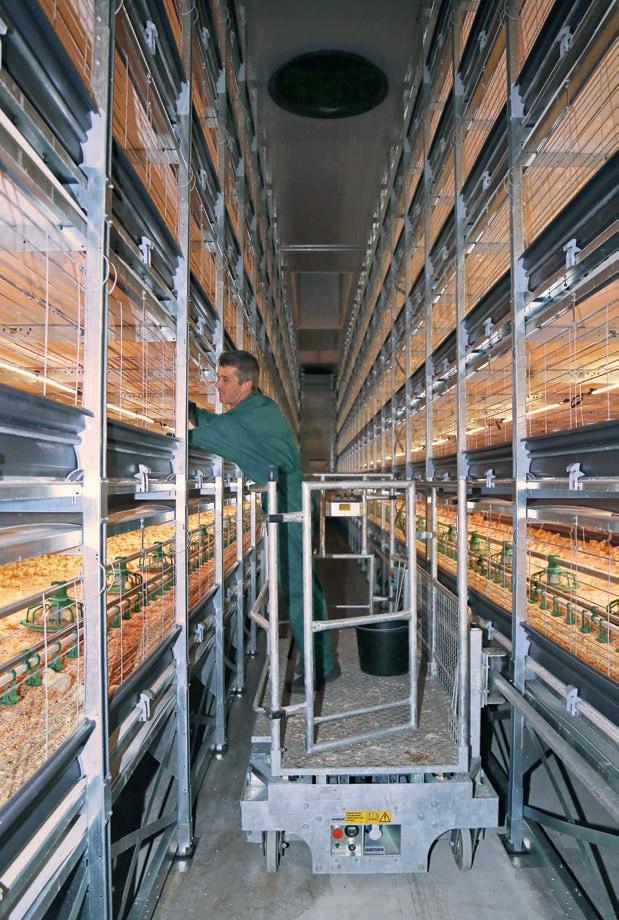
4 minute read
All-in-one misting system
from PoultryNL
Jan Kuijpers at his own hatchery. With the future poultry processing they will have the whole production chain in one farm.
PHOTO: ELLEN MEINEN, AGRIO
Advertisement
All-in-one misting system for healthy and affordable broilers
The best broiler production system offers a safe and healthy environment for the birds as well as the workers. Providing the right temperature and relative humidity creates perfect conditions to perform. That is what Jan Kuijpers of Kuijpers Kip in Grubbenvorst, the Netherlands, successfully managed to do with a unique misting concept. ‘We can rely on it and trust that we will benefit from it.’
Kuijpers Kip is a one-ofa-kind broiler farm. The building design is different from what you would expect to see when you think of a poultry farm. More than 15 years ago, the Kuijpers family started to think about growing broilers affordably and sustainably, keeping animal welfare and important environmental issues in mind. Through close collaboration with a number of institutions and poultry system manufacturers, they succeeded to build an exceptional farm. It consists of a hatchery and four attached broiler houses for 64,000 birds each. They are in the first phase of the dream to build a self-supporting broiler farm on 9 hectares of land. In the near future, three more similar units will be built,
By using very fine water droplets, the room temperature and humidity can be controlled and in case of fire the fogging system can reduce damage.
PHOTO: WIEBE VAN DER SLUIS
including a small (4,000 birds per hour) processing plant and possibly a bio-reactor.
Born inside the house
The broilers are kept in the so-called patio systems (Vencomatic) in which eggs are placed on hatcher trays at day 18 of incubation to allow the chicks to hatch inside the poultry house. ‘This allows the birds’, as Jan Kuijpers explains with enthusiasm ‘to have an excellent start without transportation stress and gives them access to feed and water right after birth. The farm is covered with 1,500 solar panels and does not use any gas heating. The desired temperature needed for the

All-in-one misting system
young birds comes from the birds in the adjacent houses by means of a clever heat recovery system. This system also cleans the air, which means no dust, no microorganisms, and only a minimum of ammonia (97% reduction) and carbon dioxide.’ The proud poultry farmer states: ‘This puts our farm on a par with the farms with the lowest environmental impact in the world.’
Multi-functional misting unit
Jan Kuijpers strongly underlines the original idea of sustainable production of affordable poultry meat for consumers who have little money to spend. ‘This requires efficiency in all segments of the operation, including environment control outside and inside the buildings’, says Jan. ‘We therefore installed a unique system made by MJ-Tech to cool the houses. With the same system we can control the humidity in the
It is amazing how precise the system is


Jurnjan van den Bremer of MJ-Tech fog systems demonstrates how it controls the climate conditions in the houses.
PHOTO: WIEBE VAN DER SLUIS
house, soak the house before cleaning and protect the birds and the facility in case of fire. Where in traditional farm houses each of these functions often require separate systems, here there is only one. It consists of one stainless steel water line with high pressure misting nozzles (0.3 mm) for cooling and humidity control and one with 1mm nozzles for soaking and fire control. The central unit is connected to a climate computer to assure sufficient cooling by using a minimum of water and energy. The small high pressure droplets (5-10 micron) prove to be efficient with consistent temperature and humidity control without causing wet spots or wet birds. Experiences tell us that this system also excels in reducing dust and smell (ammonia).’ ‘When the birds have left the poultry house, the misting system can be used to automatically soak the house with a minimum of labour and water use. Besides, it proved to be very efficient in preventing and minimising damage caused by fire. In case of fire, a smoke detector sets off an alarm and automatically turns down the ventilation rate to 30 percent after three minutes. Fifteen minutes after the alarm, the misting system will automatically be switched on. This delay provides sufficient time to personally check what is going on to avoid damage in case of a false alarm or to take adequate measures to stop the fire. This may include filling the connected houses with a mist to stop the fire from spreading. The mist reduces the oxygen level and suppresses the flames.’ ‘It is amazing how precise the system is’, Jan concludes.
Since the stocking density is high in this system, climate control
is even more important. PHOTO: ELLEN MEINEN, AGRIO











